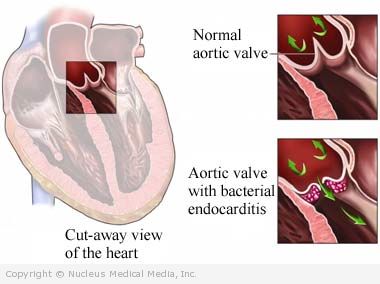Bacterial endocarditis
(Infective Endocarditis)
Bacterial endocarditis – Definition
This endocardium is a thin membrane that covers the inner surface of the heart. Bacterial endocarditis is an infection of this membrane. Infection occurs when bacteria attach to the membrane and grow.
The infection is most common when the heart or valves have already been damaged. It can be life-threatening. It can permanently impair the heart valves. This can lead to serious health problems, such as congestive heart failure.
The infection can also cause growths on the valves or other areas of the heart. Pieces of these growths can break off and travel to other parts of the body. This can cause serious complications.
Bacterial endocarditis – Causes
Bacteria can travel to the heart through the blood. It can enter the blood from an infection elsewhere in the body. It can also enter during an activity that causes breaks in the skin or mucous membranes. This activity can be dental work, surgery, or IV drug use. Only certain bacteria cause this infection. The most common are:
- Streptococci
- Staphylococci
- Enterococci
The bacteria may then be able to attach to the endocardium. Some heart conditions can increase the chance of infections. These conditions may cause blood flow to be obstructed or pool. This provides a place for the bacteria to build up.
Bacterial endocarditis – Risk Factors
The following conditions put you at greater risk during certain procedures:
- Heart valve scarring, due to rheumatic fever or other conditions
- Artificial heart valve
- Congenital heart defect
- Cardiomyopathy
- Prior episode of endocarditis
- Mitral valve prolapse, with significant regurgitation (abnormal backflow of blood)
The conditions listed above increase your risk of the infection with certain activities such as:
- IV drug use; risk is extremely high when needles are shared
- Any dental procedure, even cleanings
- Removal of tonsils or adenoids, and other procedures involving the ears, nose, and throat
- Bronchoscopy (viewing the airways though a thin, lighted tube)
- Surgery on the gastrointestinal or urinary tracks, including the gallbladder and prostate
Bacterial endocarditis – Symptoms
Symptoms vary from mild to severe, depending on:
- The bacteria causing the infection
- The amount of bacteria in the bloodstream
- The extent of structural heart defects
- Your body’s ability to fight infection
- Your overall health
The symptoms that can begin within two weeks of the bacteria entering the bloodstream include:
- Fever
- Chills
- Fatigue
- Weakness
- Malaise
- Unexplained weight loss
- Poor appetite
- Muscle aches
- Joint pain
- Coughing
- Shortness of breath
- Little red dots on the skin, inside the mouth, and/or under the nails
- Bumps on the fingers and toes
Note: The first symptom may be caused by a piece of the infected heart growth breaking off . This can include a stroke or other complication to another organ.
Bacterial endocarditis – Diagnosis
The doctor will ask about your symptoms and medical history. A physical exam will be done. The doctor will listen to your heart for a murmur.
Tests may include:
- Blood cultures to test for the presence of bacteria
- Blood tests indicating signs of infections and complications related to endocarditis
- CT scan — a type of x-ray that uses a computer to make pictures of the inside of the chest
- Electrocardiogram (ECG, EKG) — a test that records the heart’s activity by measuring electrical currents through the heart muscle
- Echocardiogram — a test that uses high-frequency sound waves (ultrasound) to examine the size, shape, and motion of the heart
- Transesophageal echocardiogram — ultrasound is passed through your mouth into the esophagus to visualize heart valves better
Bacterial endocarditis – Treatment
Treatment will focus on getting rid of the infection from the blood and heart.
Medication
Antibiotics are given through an IV into a vein. You must be admitted to the hospital for this treatment. This therapy may last for 4-6 weeks.
Surgery
The antibiotics may fail to remove the bacteria. The infection may also return. In this case, surgery may be needed.
Surgery may also be needed if there was damage done to the heart or valves from the infection.
Bacterial endocarditis – Prevention
The best way to prevent endocarditis is to avoid the use of illegal IV drugs. Certain heart conditions may increase your risk. Talk to your doctor to find out whether you are at increased risk for this condition. The American Heart Association recommends:
- People at very high risk should take antibiotics before and after certain dental and medical procedures.
In addition:
- Tell your dentist and doctors if you have any heart conditions.
- Maintain good oral hygiene:
- Brush your teeth twice daily.
- Floss daily.
- Visit your dentist for a cleaning at least every six months.
- See your dentist if dentures cause discomfort.
- Seek medical care immediately for symptoms of an infection.

